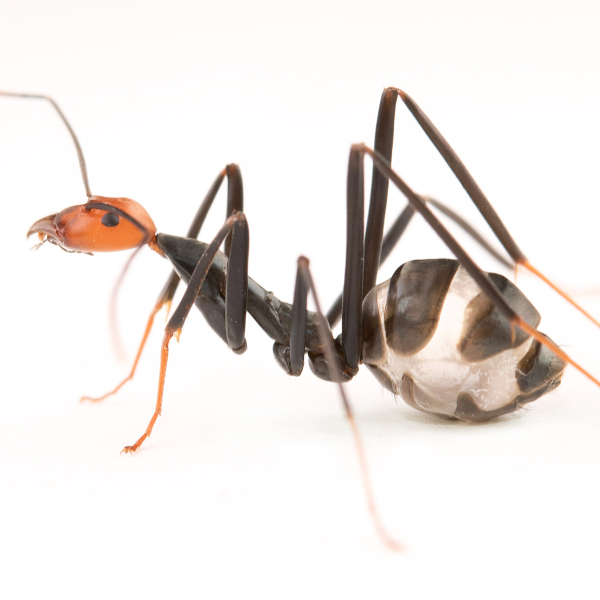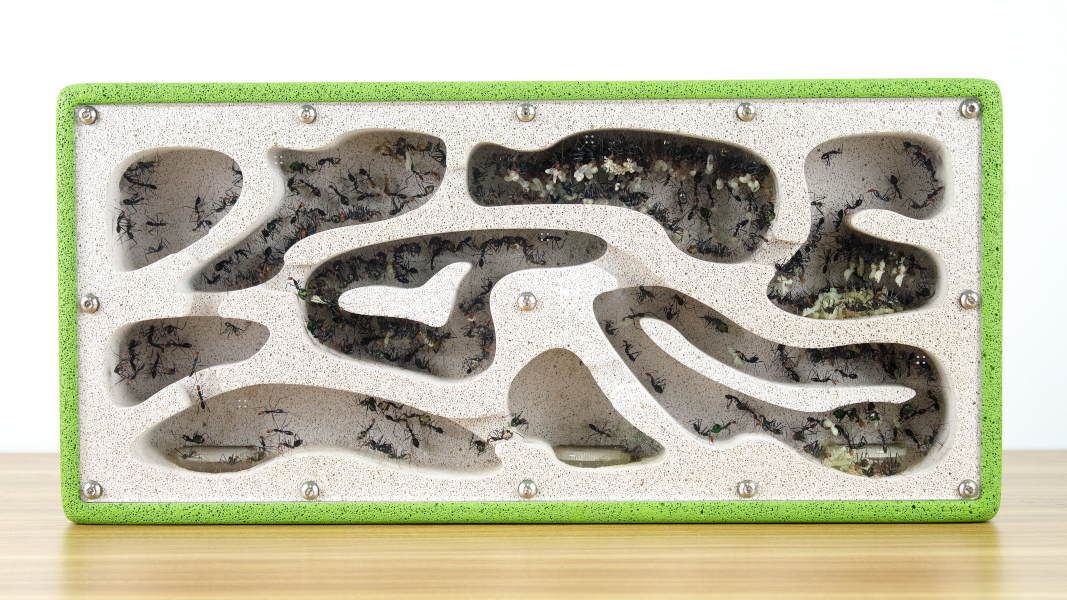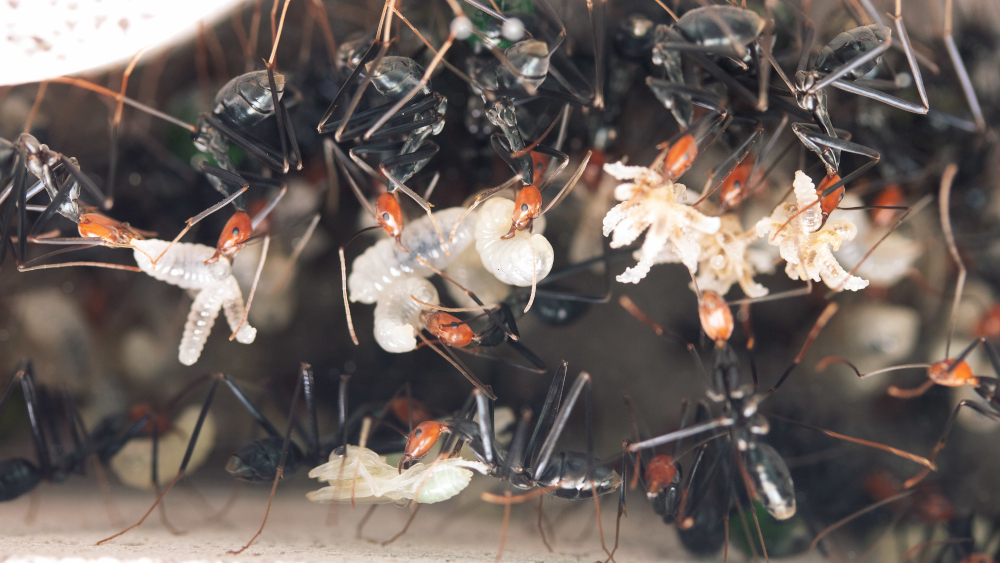Oh, what a feeling! Larvae hanging from the ceiling!
29 Aug 2022 —I’ve written here before about honeypot ants. The main takeaway is that Westerners are merely recycling the very few scientific facts and visual representations that we have about these species. To further highlight this… PAUCITY!, even a single new image is capable of changing how we think about honeypot ants—and even how we think about ants in general. I am just tickled pink to reveal that I am the vigilant myrmecologist who discovered such an image, and I was able to get a single-author publication in the prestigious scientific journal Ecology for my efforts. Although the article was changed from my initial intent during the peer-review process, I’m posting it here in its original form (and original title1).
The year was 2018—pre-pandemic, if you can imagine. I was living in Australia, studying how teams of green weaver ants cooperate to haul gigantic prey straight up walls2. However, my secret goal was to do everything I could to get closer to the different groups of Australian honeypot ants. The classic, more famous Camponotus inflatus ants turned out to be pretty inaccessible: they lived deep in the outback on protected land. Without deep personal connections to the people who lived nearby, I’d never be able to find them.
However, another group of even freakier honeypot ants lived nearby in the lush, eastern forests: ants of the genus Leptomyrmex, also called the “spider ants.” Honestly, they are some of the weirdest looking, most bizarre ants on earth. The look like someone took a normal ant and ran it through a pasta-maker. They are the Amigara ants who have “found their hole!” so to speak.

Look at that goofy-ass lookin' ant. Spaghetti girl or somethin. (Photo by Jordan Dean)
On top of all this, they actually have replete workers who are full of sugar and water too! You can easily find lone spider ants crossing the hiking trails almost anywhere on the eastern coast. However, following the individual through the forest back to their nest is tricky, and collecting colony up is almost impossible. They pick THE MOST hard-to-dig places to live: they’re always under gigantic boulders or huge tree stumps. That didn’t stop me from trying (in vain) though!
However, when browsing an Australian-based ant enthusiast Facebook group one day, I saw some photos that piqued my curiosity. An ant-keeper named Brendon Cameron had collected a colony of these spider ants, and they seemed to be doing something very… interesting. Brendon was the part owner of an Australian company that caters to other hobbyist ant-keepers named Gamergate. I eventually managed to get in touch and interrogate him about this strange behavior. Sadly, the colony in question had faded away (he hadn’t caught the queen), but Brendon forwarded me to the one other person who did have a live colony.
Jordan Dean is a filmmaker and the co-founder of the other ant hobbyist store in Australia, AusAnts—and he owned the Leptomyrmex colony. After bombarding him and his fellow founder Nick Atkins with emails, texts, and phone calls, I confirmed that his ants were also demonstrating this mysterious behavior and arranged to visit him in Melbourne before I returned the USA.

This man is a consummate professional. Even my photos of Jordan taking photos somehow look more professional than normal.
To make a long story short, the behavior was so weird, we managed to publish a scientific paper on it! Virtually all the photos are Jordan’s (at least all the good ones). If you are interested in stories about the natural world in Australia, I highly recommend checking out his YouTube channel!
Okay, yeah. This is late, I get it. I wrote the paper in 2020, and at the time I was… well.. “conflicted” about whether to publish a different never-to-be-seen, never-again-to-be-mentioned blog post. But better late than never, aye?
The Orginal Paper:
Ants are virtually the only social hymenopterans (excepting allodapine bees) whose brood do not develop in constructed cells, such as wax combs or paper cells. Because ant larvae can move or be moved throughout the nest, they can be more spatially and socially integrated within the colony, leading to an increase in what Masuko (2008)3 calls “social versatility.” Mobile and accessible larvae can be coopted for uses that cellular brood cannot: ant larvae are used for flotation in rafting ant colonies; their pupal silk can be used for water-proofing nest chambers or entirely repurposed for weaving together leaves; in highly polydomous species, they can be transported between subnests, spreading information about the queen and regulating the egg-laying rates of distant workers; their portability allows for successful colony-wide nest evacuations; and they gain specialized food-processing abilities to aid in colony digestion, often being placed on or inside prey that resist dissection.
However, utilizing these abilities requires alternative organizational modalities, and mobile brood lose access to some of the possible benefits provided from developing within cells—namely protection from cannibalism, disease, and environmental fluctuations. To address these issues, ant species have developed behavioral and morphological adaptations to spatially manage brood. Segregation of brood by age has long been observed in ants, though more sophisticated patterning may only be useful if brood are sedentary. Another approach colonies take is to suspend larvae off the ground, attaching brood to walls, ceilings, or other structures. [Other authors] describe and review the prevalent use of hooked larval hairs among myrmicines to attach brood to nest walls. The “doorknob-like” tubercles of Hypoponera are also cited as being used to keep larvae off the ground. (Interestingly, larvae of allodapine bees—the other notable example of acellular social hymenopterans—also possess modified setae and tubercles used for attachment to the walls of vertical nests.) Here, I describe an extreme, and previously undocumented, method of larval suspension in the Australian spider ant Leptomyrmex erythrocephalus.

Unlike other honeypot ant species, the honey-filled workers are still mobile. Also, if you eat them, after a brief note of sweetness, they taste like rotting coconuts. (Photo by Jordan Dean)
In 1915, pioneering myrmecologist William Morton Wheeler4 wrote that “little study has been devoted [] to the singular ants of the genus Leptomyrmex,” bemoaning that “very few observations have been recorded on the habits of any of the species”. These primarily Australasian ants possess incredibly charismatic and striking morphology: their extremely gracile features and elongated legs led to their common name of “spider ants.” Additionally, they constitute striking examples of “honeypot” ants. But despite their intriguing appearance and Wheeler’s pleas, the genus has remained virtually unstudied for the last century, excepting recent phylogenetic work. In fact, I am currently unaware of any published work on their behavioral ecology5.
However, in 2017 and 2018, two large colonies of Leptomyrmex erythrocephalus were collected during excavations for residential development near Melbourne, Australia. These two colonies were acquired by Gamergate™ and AusAnts™ respectively, two Melbourne-based businesses catering to ant keeping enthusiasts. The first colony was excavated by a proprietor of Gamergate™, Brendon Cameron, and the second colony was excavated further from the city in Woodend, Victoria by ant enthusiast David Goode and subsequently given to Jordan Dean of AusAnts™. Both colonies were housed in artificial nests made of autoclaved aerated concrete (a commonly used substrate for hobbyist formicaria), custom-made to resemble the natural chamber sizes and morphologies observed during the first colony’s initial excavation. Both were also designed as observation formicaria to allow for frequent and non-disruptive monitoring within the nest. As [other authors] note, many ant behaviors may only be expressed when colonies are housed in realistic nests.

This is a wonderfully built nest, but do you spot the weird behavior yet? (Image by Jordan Dean)
In both recorded captive L. erythrocephalus colonies, when presented with adequate space, ~20% of in-nest workers would hang, bat-like, from the chamber ceilings and continually suspend larvae off the ground between their mandibles. In the first colony, virtually all brood were continuously held off the ground, although in the second colony, a fraction of the pupae and late-instar, non-feeding larvae were arranged in a pile on the floor. Larvae were often held in clumps (sometimes of 10 or more), attached to one another via their anterior ends. Suspended brood remained so throughout their captivity. The first colony, lacking a queen, suspended larvae until all larvae eclosed, and the second colony continues to this day (almost two years later).

THIS IS IT, BABY! This zoomed-in shot shows how they just hang like bats, grabbing on to all the larvae? (Image by Jordan Dean)
While attempting to make sense of this bizarre phenomenon, it became apparent that many ant species, across subfamilies, exhibit similar but less extreme behaviors. I was able to find records of larvae being suspended or kept off chamber floors in eight of the major subfamilies. Although the adaptive value of larval suspension is still largely untested and not understood, likely due to the dearth of published research on insect larvae, the infrequency at which ants are kept in “natural-like” nests, and the deemphasis of natural history approaches in myrmecology. However, there are several hypotheses present in the literature.
Firstly, this larval suspension behavior might help regulate the larvae’s environment in respect to temperature, humidity, or exposure to pathogens. Ants will often continually move brood to track optimal temperatures and humidity levels, and [other authors] demonstrated that ants will use larval hairs to stick brood in environmentally ideal locations. Army ants will position brood in the center of their bivouac and regulate temperature and humidity based on the brood’s developmental age. However, in the case of the captive Leptomyrmex colonies, temperatures inside the nest were presumably uniform, and most suspension occurred in the drier sections of the nest.

It's just soooo weird! Look how they're all stuck together like that! (Image by Jordan Dean)
Secondly, suspension of larvae on ceilings or nest chamber walls could facilitate food distribution among brood. The arrangement of ant larvae is often associated with differential feeding and development rates. However, Leptomyrmex pupae and nonfeeding larvae were also suspended, though in the second colony, these stages appeared to be suspended at a lower frequency than younger larvae.
The prevention of larval cannibalism is another proposed reason why larvae might be separated and anchored to fixed positions. In support of this explanation for this behavior seen in Leptomyrmex, only smaller, similarly sized larvae were clumped and held together, which would presumably make cannibalism more difficult. However, comparable segregation could also result if the total larval mass being held was a limiting factor. Larger larvae might be too heavy or cumbersome to suspend in groups.

It's interesting, because as the largest larvae transition into pupae, they stop being able to feed. (In this species, pupae are "naked" and don't form cocoons.) And it seemed that most of these huge, non-feeding larvae were piled up separately on the ground... Because they won't eat each other or because they're too big to hold efficiently?
Unlike the previously described behaviors from other ant species, Leptomyrmex suspension could also represent preparations for absconding from the nest. In the face of nest disruption or predation by army ants, many ant species exhibit extreme escape responses, with workers fleeing while carrying immobile brood. Although there were no obvious threats or continued disruptions to the captive Leptomyrmex erythrocephalus colonies, this behavior continued for months and years, suggesting that it is not an acute response to external stressors. It seems likely that normal maintenance of a colony-wide state of “ready mobilization” would be advantageous given that: 1) colonies contain many replete workers that are swollen with sugary liquids, 2) the genus lacks any obvious defensive adaptations to protect these valuable “honeypots” from predators, and 3) Leptomyrmex species are observed to readily abscond with larvae when disturbed in the wild. Additionally, unlike honeypot ant species from other genera, Leptomyrmex repletes remain mobile and could easily escape with an absconding colony.
There is still the possibility that this active suspension represents an artifact of the ants being housed in an aerated concrete nest. Although this material is widely used as a nesting substrate across ant species and, to my knowledge, has not elicited similar results, perhaps it has some quality that compels L. erythrocephalus workers to hold their larvae aloft. This choosiness seems unlikely, as I have seen Leptomyrmex ants nesting in a wide variety of substrates: within stumps, among piles of boulders, and in abandoned animal burrows. Nonetheless, this behavior, and that of larval suspension in general, certainly demands further investigation.
I write this natural history note—again echoing Wheeler from 1915—”in the hope that some of my entomologist friends in Australia may be induced to make a more exhaustive study. The species of Leptomyrmex, unlike so many Australian ants, are perfectly harmless and would, no doubt, live well in artificial nests of rather simple construction. The entomologist who could devote a little patient study to these insects under such conditions would unquestionably be rewarded by obtaining answers.”
The end.
Hope you enjoyed the paper! The published version is quite a bit different, so if you’re interested, check it out too. (cough, use sci-hub, cough)
Footnotes
-
Man, can you believe the editors didn’t appreciate my clever reference to American singer Lionel Richie’s 1986 album and song of the same name? The editors also rejected my backup title of “The Floor is La(r)va!” … SMH. ↩
-
You can read about my findings in this preprint here! ↩
-
I’m removing almost all of the references from the paper because I don’t think casual blog readers will care about that sort of thing. But this one is pretty important to the driving theory here, it’s K. Masuko’s “Larval stenocephaly related to specialized feeding in the ant genera Amblyopone, Leptanilla and Myrmecina (Hymenoptera: Formicidae)”. ↩
-
Squeeee! W.M.W. is one of the great-grandaddies of myrmecology. ↩
-
I’ve since found a single paper that looks at the sort of food a few colonies collected. Eh. ↩